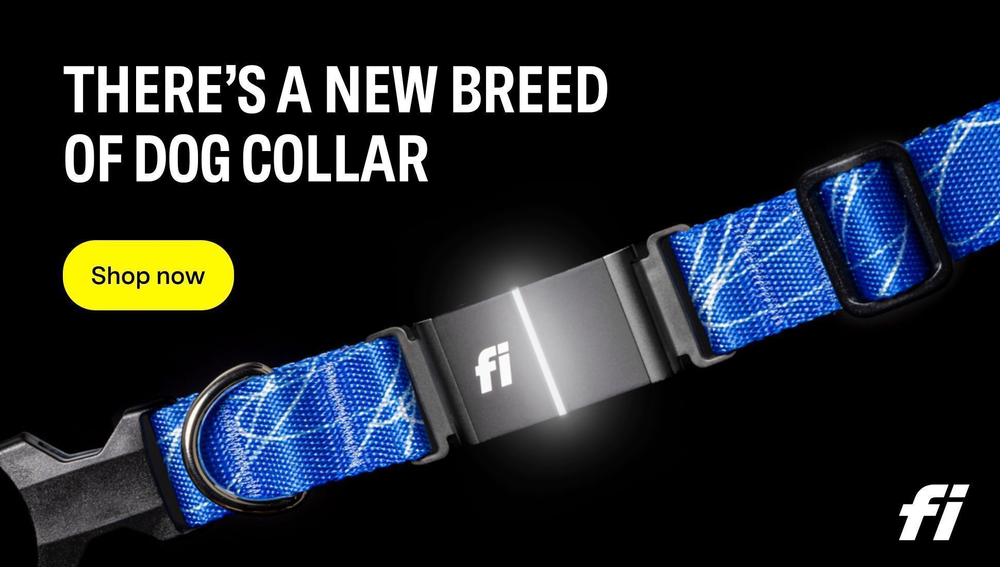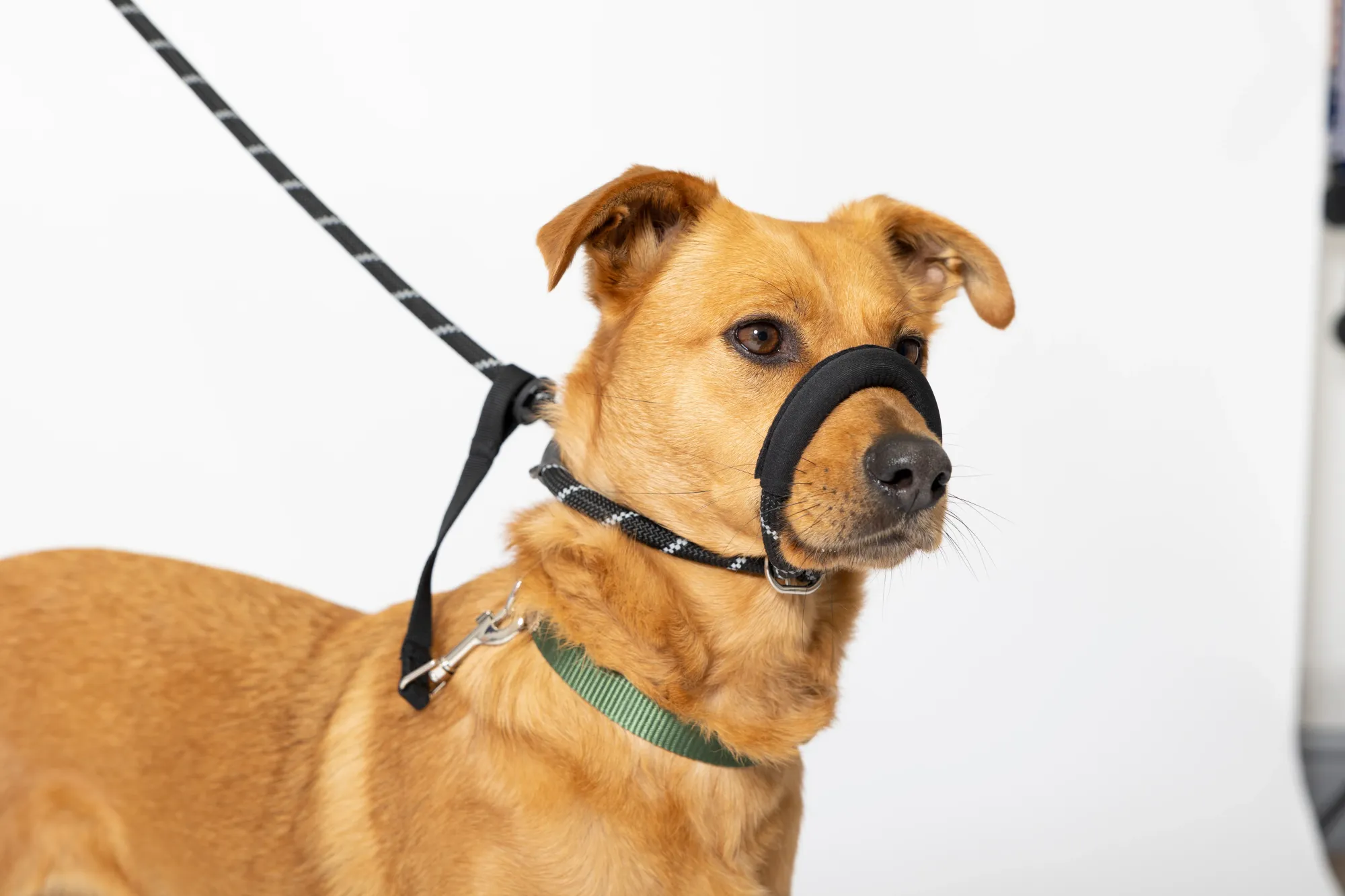Dogs have been man's closest companion for thousands of years, and it is not uncommon to see them adorned with collars. But why do dogs wear collars? There are several reasons why collars are a common accessory for dogs.

Firstly, collars help to identify a dog and its owner. Most dog collars have a tag with the dog's name and the owner's contact information. This makes it easier for people to return a lost dog to its rightful owner. In addition, some collars have reflective materials that make it easier for drivers to spot dogs at night, reducing the risk of accidents.
Secondly, collars are used as a training aid. Many dog owners use collars to teach their dogs basic obedience commands. Collars can be used to control a dog's behavior by giving a quick tug when the dog misbehaves. This helps to reinforce good behavior and discourage bad behavior.
Overall, collars are an essential accessory for dogs. They not only help to identify a dog and its owner, but they also serve as a training aid. Whether it's a simple leather collar or an elaborate designer collar, collars are an important part of a dog's life.

The Purpose of Dog Collars
Dog collars have been used for centuries, and they serve a variety of purposes. In this section, we will explore the different reasons why dogs wear collars, including identification and safety, training and control, and protection and comfort.
Identification and Safety
One of the primary reasons for dogs to wear collars is for identification and safety. A collar with an ID tag can help a lost dog find his way back home. Additionally, a collar can help identify a dog as belonging to someone, which can prevent theft or other dangerous situations. Microchipping is also a popular option for identification, but a collar with a tag is a more visible and immediate way to identify a lost dog.
Training and Control
Another reason for dogs to wear collars is for training and control. A collar can serve as a training tool when used with positive reinforcement techniques. It can also be used to attach a leash for leash training, which is essential for teaching a dog to walk properly on a leash. The collar can also provide control over the dog's movements and behavior, especially in situations where the dog may be tempted to run or chase after something.
Protection and Comfort
Finally, dog collars can also provide protection and comfort. A properly fitted collar can prevent a dog from slipping out of it and running away. A harness is also an option for dogs who tend to pull on their leash, as it distributes the pressure more evenly across the dog's body. Additionally, some collars are designed for comfort, with padded materials or adjustable features that can prevent chafing or discomfort.
In summary, dog collars serve a variety of purposes, including identification and safety, training and control, and protection and comfort. By understanding these different reasons for wearing a collar, dog owners can choose the best collar for their pet's needs and ensure their dog's safety and comfort.
Types of Collars and Their Uses
When it comes to dog collars, there are a variety of options available. Each type of collar serves a specific purpose, and choosing the right one depends on the dog's breed, size, and behavior. Here are the most common types of collars and their uses:
Standard Flat Collars
The standard flat collar is the most common type of collar. It is made of materials such as leather or nylon and has a buckle or snap closure. This type of collar is suitable for most dogs and is used for everyday wear, identification, and leash attachment.
Martingale and Choke Collars
Martingale and choke collars are designed for dogs that tend to pull or slip out of their collars. These collars tighten around the dog's neck when they pull, preventing them from escaping. The martingale collar has a limited tightening action, while the choke collar tightens until the dog stops pulling. These collars should only be used under supervision and should never be left on the dog when unsupervised.
Harnesses and Alternatives
Harnesses are an alternative to collars and are suitable for dogs with respiratory problems or neck injuries. They distribute the pressure evenly across the dog's body and prevent choking. There are different types of harnesses available, such as the front-clip harness and the back-clip harness. The front-clip harness is designed to discourage pulling, while the back-clip harness is suitable for dogs that do not pull.
Breakaway collars are designed to release when the dog pulls too hard, preventing choking or injury. Shock collars should only be used as a last resort and under the guidance of a professional trainer. They deliver an electric shock to the dog's neck when they misbehave, which can cause physical and emotional harm.
In conclusion, choosing the right collar for a dog depends on their breed, size, and behavior. The standard flat collar is suitable for most dogs, while martingale and choke collars are designed for dogs that tend to pull or slip out of their collars. Harnesses are an alternative to collars and are suitable for dogs with respiratory problems or neck injuries. Breakaway collars and shock collars should only be used under supervision and as a last resort.
Choosing the Right Collar
When it comes to choosing the right collar for your dog, there are a few important factors to consider. The collar should be comfortable and secure, and it should fit properly to ensure your dog's safety. Here are some things to keep in mind when selecting a collar for your furry friend.
Fit and Size
One of the most important considerations when choosing a collar is ensuring that it fits your dog properly. A collar that is too loose can slip off, while one that is too tight can be uncomfortable or even cause injury. To get the right fit, measure your dog's neck and choose a collar size accordingly. It's also important to consider the shape of your dog's neck, as some breeds may require a collar with a wider or narrower band.
Material and Durability
The material of the collar is another important factor to consider. Leather collars are durable and can last a long time, but they may not be the best choice for dogs with sensitive skin. Nylon collars are lightweight and come in a variety of colors and patterns, but they may not be as durable as leather. When selecting a collar, consider your dog's activity level and lifestyle to determine which material will be best suited for their needs.
Dog's Age and Breed

The age and breed of your dog can also play a role in selecting the right collar. Puppies may require a smaller collar that can be adjusted as they grow, while older dogs may benefit from a collar with extra padding for added comfort. Certain breeds may also require specific types of collars, such as a martingale collar for dogs with narrow heads or a harness for dogs with respiratory issues.
Overall, choosing the right collar for your dog is an important decision that requires careful consideration. By taking into account factors such as fit, material, and your dog's age and breed, you can ensure that your furry friend stays safe and comfortable while wearing their collar.
Collar Safety and Health Considerations
When it comes to dogs wearing collars, safety and health considerations should always be a top priority for their owners. While collars are an essential tool for identification and control, they can also pose potential risks and injuries if not used properly.
Potential Risks and Injuries
A tight or uncomfortable collar can cause pain and discomfort for dogs, especially if it chokes them or puts pressure on their trachea or thyroid gland. This can lead to serious health issues, such as respiratory problems and damage to the neck and spine.
Moreover, collars can also pose a risk of injury if they get caught on objects or other dogs during play or exercise. This can result in choking, strangulation, or even death if the collar is not designed to break away in case of emergency.
Signs of Discomfort and Stress
Dogs can show signs of discomfort and stress if their collar is too tight or uncomfortable. These signs may include pawing at the collar, rubbing their neck against furniture or walls, or trying to remove the collar with their mouth.
Additionally, dogs may exhibit signs of stress, such as panting, pacing, or whining, if they feel restricted or uncomfortable in their collar. Owners should pay close attention to these signs and adjust the collar accordingly to prevent further discomfort and potential injury.
Avoiding Skin Irritation
Collars can also cause skin irritation, especially if the dog has sensitive skin or allergic reactions to certain materials. Owners should choose collars made of soft, breathable materials that won't rub or irritate the dog's skin.
Regular cleaning and maintenance of the collar is also essential to prevent the buildup of dirt, bacteria, and other harmful substances that can cause skin irritation or infection.
In conclusion, while collars are an essential tool for dogs, their safety and health should always be a top priority for their owners. By following proper collar safety and health considerations, owners can ensure their dogs are comfortable, healthy, and safe while wearing their collars.
Collar Maintenance and Care
Cleaning and Inspection
Keeping a dog's collar clean and well-maintained is important for both the dog's comfort and health. Collars made of different materials require different cleaning methods. For example, leather collars should be cleaned with a damp cloth and saddle soap, while nylon collars can be washed in a washing machine.
It is also important to regularly inspect the collar for any signs of wear and tear. This includes checking for frayed edges, loose stitching, and cracks in the material. If any damage is found, the collar should be replaced immediately to ensure the dog's safety.
When to Replace a Collar
Even with proper maintenance and care, collars will eventually need to be replaced. The frequency of replacement will depend on factors such as the material of the collar, the dog's activity level, and how well the collar is maintained.
As a general rule, flat collars made of nylon or leather should be replaced every 6-12 months. If the collar is showing signs of wear and tear before this time, it should be replaced sooner. For collars made of more durable materials, such as metal or chain collars, replacement may not be necessary as frequently.
It is important to ensure that the collar is properly fitted to the dog's neck. A collar that is too loose can easily slip off, while a collar that is too tight can cause discomfort or even injury to the dog. Checking the fit of the collar regularly and adjusting it as needed can help prevent these issues.

By following these tips for collar maintenance and care, dog owners can help ensure their pet's safety and comfort.
Responsible Collar Usage
When it comes to using collars on dogs, responsible pet owners understand the importance of positive association and training, balancing control and comfort, and understanding their dog's personality.
Positive Association and Training
Responsible dog owners know that collars can be a great tool for training, but only if they are used properly. Positive reinforcement is key to effective training, and treats can be a great way to encourage good behavior. By associating the collar with positive experiences and rewards, dogs can learn to respond to commands and feel more comfortable wearing a collar.
Balancing Control and Comfort
While collars can provide control and safety for dogs, they should never compromise their comfort or freedom. It's important to choose a collar that fits properly and doesn't cause discomfort or injury. A collar that is too tight can cause breathing difficulties, while one that is too loose can slip off or get caught on something. By finding the right balance between control and comfort, pet owners can ensure their dog's safety and well-being.
Understanding Your Dog's Personality
Every dog is unique, and responsible pet owners understand the importance of understanding their dog's personality. Some dogs may be more sensitive or reactive to certain types of collars, while others may require more control or training. By taking the time to get to know their dog's personality and needs, pet owners can choose a collar that is best suited for their individual dog.
Overall, responsible collar usage involves positive association and training, balancing control and comfort, and understanding your dog's personality. By following these guidelines, pet owners can ensure the safety and well-being of their furry friend, while also using collars as an effective tool for training and control.
Frequently Asked Questions

- Q1: What are the reasons for a dog to wear a collar?
- A dog collar serves several purposes, including identification, training, and control. Collars with identification tags help reunite lost dogs with their owners. Training collars, such as martingale collars, can be used to teach dogs not to pull on a leash. Collars with quick-release buckles provide a safety mechanism in case a dog gets caught on something.
- Q2: Is it safer for a dog to use a harness instead of a collar?
- It depends on the individual dog and their needs. Harnesses can be helpful for dogs with respiratory issues or neck injuries, as they distribute pressure evenly across the body. However, collars can be more effective for controlling and training dogs, especially those who pull on a leash. It's important to choose the right type of collar or harness for your dog's specific needs and to ensure a proper fit.
- Q3: Can wearing a collar all the time be harmful for dogs?
- Wearing a collar all the time can cause skin irritation, hair loss, and discomfort if the collar is too tight or poorly fitted. It's recommended to remove collars when dogs are indoors or in a safe, fenced-in area. If a dog is prone to escaping, a breakaway collar can be a safer option.
- Q4: How do collars benefit dogs when used alongside harnesses?
- Collars and harnesses can work together to provide additional control and safety for dogs. A collar can be used for identification and training while a harness can be used for control and comfort during walks. Using both can also help prevent dogs from slipping out of their collars if they get overly excited or scared.
- Q5: What are the considerations for having a dog wear a collar indoors?
- It's generally recommended to remove collars when dogs are indoors to prevent discomfort and injury. However, if a dog is prone to escaping or has a medical condition that requires a collar, a breakaway collar or a soft, comfortable collar can be used.
- Q6: At what age should a puppy start wearing a collar regularly?
- Puppies can start wearing collars as early as 8 weeks old. It's important to choose a lightweight, adjustable collar that fits snugly but not too tightly. Gradually increase the amount of time the puppy wears the collar to allow them to get used to it. Always supervise puppies when they are wearing collars to ensure they don't get caught on anything or become injured.




